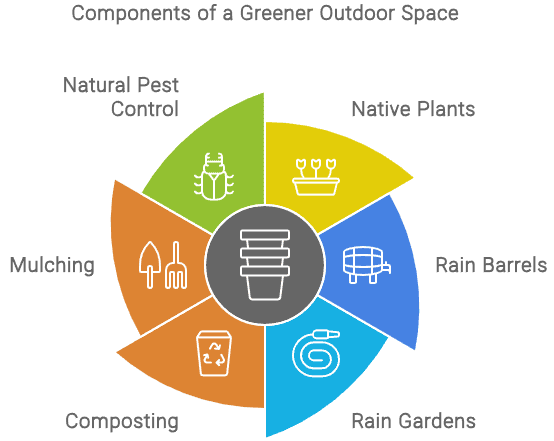Eco-friendly living is a lifestyle that prioritizes the well-being of the planet and its inhabitants. It involves making conscious choices to reduce one’s environmental impact and promote sustainability. This can be achieved through various practices such as energy conservation, sustainable transportation, waste reduction, eco-friendly shopping, sustainable food choices, and creating a greener outdoor space. By adopting eco-friendly living practices, individuals can contribute to the preservation of the environment and the health of future generations.

Energy Conservation in the Home
Energy conservation in the home is a crucial aspect of eco-friendly living. There are several ways to reduce energy consumption, such as using energy-efficient appliances, installing programmable thermostats, and improving insulation. Additionally, utilizing natural light and turning off lights and electronics when not in use can significantly reduce energy usage. Another effective way to conserve energy is by using renewable energy sources such as solar panels or wind turbines. By implementing these practices, individuals can not only reduce their carbon footprint but also save money on energy bills.
In addition to these measures, individuals can also consider making small changes in their daily habits to conserve energy. For example, using cold water for laundry, air-drying clothes instead of using a dryer, and unplugging electronics when not in use can all contribute to energy conservation. By being mindful of their energy usage, individuals can make a positive impact on the environment and contribute to a more sustainable future.
Sustainable Transportation Options
Sustainable transportation options are essential for reducing carbon emissions and promoting eco-friendly living. One of the most effective ways to achieve this is by using public transportation, biking, or walking instead of driving a car. Public transportation not only reduces individual carbon footprints but also helps alleviate traffic congestion and air pollution. Biking and walking are also great alternatives that promote physical activity and reduce reliance on fossil fuels.
For those who need to use a car, there are still ways to make transportation more sustainable. Carpooling, using fuel-efficient vehicles, and maintaining proper tire pressure can all contribute to reducing carbon emissions. Additionally, electric or hybrid vehicles are becoming increasingly popular as they offer a more environmentally friendly alternative to traditional gasoline-powered cars. By choosing sustainable transportation options, individuals can play a significant role in reducing their environmental impact and promoting a healthier planet.
Reducing Waste and Recycling
Reducing waste and recycling are essential components of eco-friendly living. One way to minimize waste is by choosing products with minimal packaging or opting for reusable items instead of single-use ones. This can include using reusable water bottles, shopping bags, and food containers. Composting organic waste is another effective way to reduce the amount of waste sent to landfills while also creating nutrient-rich soil for gardening.
Recycling is also a critical aspect of waste reduction. By sorting and recycling materials such as paper, glass, plastic, and metal, individuals can help conserve natural resources and reduce the energy required for manufacturing new products. Additionally, supporting businesses that use recycled materials in their products can help create a market for recycled goods and promote a circular economy. By incorporating these practices into their daily lives, individuals can significantly reduce their environmental impact and contribute to a more sustainable future.
Eco-Friendly Shopping and Consumer Choices
Eco-friendly shopping and consumer choices play a significant role in promoting sustainability. One way to make more environmentally friendly choices is by supporting businesses that prioritize sustainability and ethical practices. This can include purchasing products from companies that use eco-friendly materials, minimize waste in their production processes, and prioritize fair labor practices. Additionally, choosing products with eco-friendly certifications such as organic, Fair Trade, or Energy Star can help consumers make more informed decisions.
Another important aspect of eco-friendly shopping is reducing consumption and embracing minimalism. By prioritizing quality over quantity and avoiding unnecessary purchases, individuals can reduce their environmental impact and contribute to a more sustainable economy. Additionally, repairing and repurposing items instead of discarding them can help extend the lifespan of products and reduce waste. By making conscious consumer choices, individuals can support businesses that prioritize sustainability and contribute to a more environmentally friendly economy.
Sustainable Food Choices and Meal Planning
Sustainable food choices and meal planning are essential components of eco-friendly living. One way to make more sustainable food choices is by prioritizing locally sourced and organic produce. Supporting local farmers and choosing organic products can help reduce the environmental impact of food production while also promoting healthier eating habits. Additionally, reducing meat consumption and incorporating more plant-based meals into one’s diet can significantly reduce carbon emissions and promote animal welfare.
Meal planning is another effective way to reduce food waste and promote sustainability. By planning meals in advance and only purchasing what is needed, individuals can minimize food waste and save money on groceries. Additionally, utilizing leftovers and incorporating them into future meals can help reduce waste while also providing convenient and nutritious options for meals. By making sustainable food choices and practicing mindful meal planning, individuals can contribute to a more environmentally friendly food system.
Creating a Greener Outdoor Space
Creating a greener outdoor space is an important aspect of eco-friendly living that often goes overlooked. One way to achieve this is by incorporating native plants into landscaping designs. Native plants are well adapted to local climates and require less water and maintenance than non-native species, making them an environmentally friendly choice for outdoor spaces. Additionally, utilizing rain barrels or installing a rain garden can help capture rainwater and reduce runoff while also providing water for plants.
Another way to create a greener outdoor space is by implementing sustainable gardening practices such as composting, mulching, and using natural pest control methods. Composting organic waste not only reduces the amount of waste sent to landfills but also provides nutrient-rich soil for gardening. Mulching helps retain moisture in the soil and suppresses weed growth, reducing the need for water and chemical herbicides. Using natural pest control methods such as companion planting or introducing beneficial insects can help maintain a healthy garden ecosystem without relying on harmful pesticides.
In conclusion, eco-friendly living encompasses a wide range of practices that prioritize sustainability and environmental stewardship. By implementing energy conservation measures in the home, choosing sustainable transportation options, reducing waste and recycling, making eco-friendly shopping choices, practicing sustainable food choices and meal planning, and creating a greener outdoor space, individuals can make a significant impact on the health of the planet and future generations. Through conscious choices and mindful practices, eco-friendly living offers a path towards a more sustainable and environmentally friendly lifestyle.




